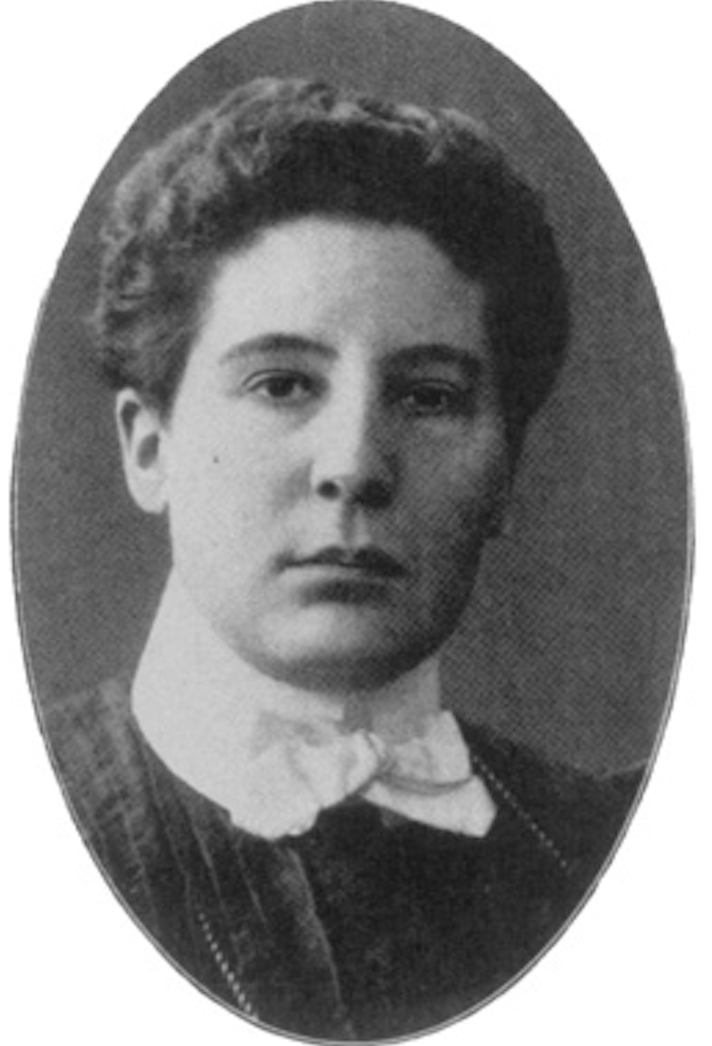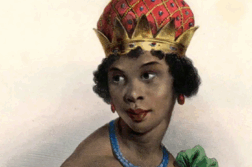“THE WOMEN’S MOVEMENT is a historical and cultural necessity. Homosexuality is a historical and cultural necessity, and homosexuality is an obvious and natural bridge between man and woman.” With this pronouncement in a speech delivered just one century ago, in Germany, Anna Rüling became the first known lesbian activist.
Until very recently, little had been known about the life of Anna Rüling. She gave her interesting and expressive speech—“What Interest Does the Women’s Movement Have in Solving the Homosexual Problem?”—in 1904 before the Scientific-Humanitarian Committee. The Committee, the first gay organization in world history, was established in Berlin in 1897 by Magnus Hirschfeld. In her speech, Rüling brought homosexual rights and women’s rights together under one umbrella. She congratulated the Committee for its support of women’s rights and for including lesbians, along with homosexual men, in its fight for equal rights.

The involvement of lesbians in the worldwide women’s movement continues to be as important an issue today as it was at the time of Rüling’s speech. At the outset of her speech, Rüling makes the point that women have been considered only as an afterthought in the fight for equal rights. Although she’s not complaining, she suggests that this is due to the general absence of laws against the practice of sexual acts between women—men were not so lucky—that has kept women on the sidelines in the fight for sexual liberty. Rüling uses both the term “homosexuality,” which was coined by Karl Maria Kertbeny in 1868, and the term “Uranism,” which was coined by Karl Heinrich Ulrichs in 1862.
On the one hand, Rüling can be seen to invoke many of the economic and social arguments that are still current today, notably when addressing the circumstances that perpetuate inequality between men and women in the workplace and in the home. She speaks about gender stereotypes whereby jobs are said to be fit for one of the sexes only. She questions the conventional gender roles in a way that a modern reader would not find out of place in a contemporary speech.
On the other hand, Rüling’s remarks about conjugal unions between homosexuals and heterosexuals would be difficult for modern readers to accept, to say the least. Such a union, she maintains, would produce offspring doomed to join the ranks of the “weak-minded, idiotic, epileptic, chest-diseased degenerates of all sorts,” who would have “unhealthy sexual drives such as sadism and masochism.” Such comments must be understood in the context of the dominant perspective of the physicians and psychiatrists of her day, who diagnosed “homosexuality” and “Uranism” as a disorder that gave rise to all kinds of undesirable consequences. While accepting this proposition, Rüling’s purpose is to discourage people from falling into the trap of heterosexual marriage when their instincts are leading them elsewhere.
But Rüling sounds modern again when she points to the impossibility of changing a person’s sexual orientation by force or other means. She’s also sensitive to parents’ inability to know the sexual orientation of their children. And her advice to parents concerning problems related to the sexuality of their children is to offer them love and understanding.
Finally, however, at the core of Rüling’s account is her very un-modern claim that “men, women, and homosexuals” constitute three distinct types of person. Like her contemporaries in biology and psychoanalysis, Rüling subscribed to the existence of a third sex, a kind of intermediate type or “invert” that was neither male nor female. While the three types were seen to differ in their psychological makeup, Rüling, for her part, insisted that all three should have equal opportunities in education and in the job market.
On balance, Rüling was clearly way ahead of her time with respect to gender equality and gay rights, and it is perhaps for this reason that her speech remained obscure through most of the last century. Simone de Beauvoir cited Rüling as a reference in The Second Sex, published in 1949. But only in recent decades has Rüling’s speech been rediscovered and its importance recognized.
Since my push in May 2003 for recognition of the 100th anniversary of Rüling’s speech, three websites have put it online, one of them a translation into Italian. More significantly, though, is the first biography of this “conflicted forebear of lesbian herstory,” by Christiane Leidinger, which was published in December 2003. Leidinger revealed that the name Rüling is a pseudonym of Theo Anna Sprüngli. Thanks to Leidinger, we now know the birth and death dates and important places, and even have photographs of Rüling. (Leidinger’s article appears in the Mitteilungen der Magnus-Hirschfeld-Gesellschaft.)
As a note of interest, Rüling’s own sexual orientation can only be deduced from the speech’s text in a roundabout way. At one point she refers to the widely held belief that “in middle-class circles … homosexuality has no place,” and notes that her father subscribed to this conviction, having spoken once about homosexuality and declared that “nothing of the sort can happen in my family.” She then adds, a bit cryptically: “The facts prove the opposite. I need to add nothing to that statement.”
However atavistic some of her ideas, Rüling deserves the attention of today’s gay and non-gay readership. Her notion that the women’s movement and the homosexual movement share a common cause has proven prophetic, even if it took until the 1960s for both women and gay people to assert their claim to full equality. And since neither group has fully achieved that goal at the centennial of Anna Rüling’s speech, her pleas for the recognition of the essential equality of all human beings, regardless of gender or sexual orientation, remain as relevant as ever.
What Interest Does the Women’s Movement Have in Solving the Homosexual Problem?
(Excerpt)
by Anna Rüling
Ladies and Gentlemen,
The Women’s Movement is a historical and cultural necessity. Homosexuality is a historical and cultural necessity, and homosexuality is an obvious and natural bridge between man and woman.
Today this is an undisputed scientific fact which the ignorant and impatient cannot dispute. Many people have asked how I came to this conclusion and could utter the truth about historical and cultural and natural and historical concepts in one breath, two things which on the surface seem to be opposites.
The interest to research, the reason for this extended viewpoint, is that people in general, when the matter concerns homosexuals, think only of male Urnings and overlook how many female homosexuals there are. They are, of course, less discussed because they—I was just about to say “unfortunately”—have had no unjust cause to fight against, such as penal code paragraphs which arise out of having false moral views.
No cruel justice menaces women nor does the penitentiary if they follow their natural instincts. But the mental pressure which Urninds suffer is just as great, indeed even greater than the yoke which their male fellow-sufferers must bear.
To the world which judges by outward appearances they are even more obvious than the female Urning. Only too often they are overwhelmed by people’s moralized misunderstandings. In our total social life, however, Uranian women are at least just as important as their male counterparts because they influence our lives in many ways, even if they are not discussed.
If people would just observe, they would soon come to the conclusion that homosexuality and the Women’s Movement do not stand opposed to each other, but rather they aid each other reciprocally to gain rights and recognition, and to eliminate the injustice which condemns them on this earth.
The Homosexual Movement fights for the right of all homosexuals, for men as for women. …
Homosexual women have many characteristics, inclinations, and abilities which we usually consider as valid for men. They take much less interest in the emotional life than the average woman. While for the expressly heterosexual woman, feeling is almost always—even here exceptions prove the rule—dominant and decisive, while mostly a sharp clarity and reason predominate in the Urnind.
She is, as in the average, normal man, more objective, more energetic and goal-oriented than the feminine woman; she thinks and feels like a man; she does not imitate a man; she is conditioned as he; this is the all-decisive point which haters and calumniators of so-called “men-women” always ignore, because they do not even take the time to do basic research on the homosexual.
It is easy to judge what one does not understand, and it is just as easy, even if it only seems to be difficult to correct pre-established and false opinions, to correct them by reasoning.
I would like to note that there is an absolute and a separate psychic homosexuality, that, therefore, masculine characteristics do not necessarily and unconditionally result in the sexual drive being forced toward one’s own sex; because each Urnind naturally possesses numerous feminine characteristics to a certain degree, which may be expressed in one of the numerous intermediate stages in the transitional stages between the sexes, even by being sexually attracted to a man.
Of course, the drive in these cases is in most cases directed to a very effeminate man, as a natural completion of the woman who has a strong masculine soul. I recall, for example, George Sand and Daniel Stern, who both loved men, those on the side of the feminine, Friedrich Chopin and Franz Liszt. Klara Schumann, the great artist, also, was married to a man who had strong feminine characteristics—Robert Schumann.
It seems, moreover, as if in the women whom I have characterized as psychic homosexuals, the sex drive was never especially strongly developed; even George Sand and Daniel Stern loved their artists much more with their souls than with their senses; therefore, I am inclined to speak of psychic homogenic women somewhat as “sexless” natures.
Since a woman who has a masculine nature and masculine traits would never satisfactorily fulfill a full-fledged man, without further ado, it is clear that the Urnind is not suitable for marriage. Even Uranian women know this is true or feel this way. Unconsciously and naturally they voluntarily refuse to walk up the aisle to the justice of the peace.
But how often had they to deal with parents, cousins, aunts, and other dear friends and relatives who, day in and day out, try to talk them into the necessity of marriage and make life a misery with their wise advice.
Many Important Women Have Been Homosexual
There are men who, like Weininger, believe that all great historical, literary, scientific, or otherwise important or famous women have been homosexuals.
According to my past statements, I do not have to especially accentuate that this highly one-sided view is unproved, because not only history but also our own eyes daily show us the weakness in this theory. On the other hand, I would not deny that many important women have been homosexual, just to mention Sappho, Christine of Sweden, Sonja Kowalewska, Rosa Bonheur. However, it would seem strange if one wanted to classify Elizabeth of England and Catherine the Great of Russia as Uranian persons; the latter was perhaps bisexual—her many male and female “friendships” seem to imply this—a pure homosexual, however, she was not.
In opposition to the anti-feminists who claim that the female sex is inferior and who acknowledge only those women who exhibit strong masculine characteristics, I accept both as equals, but I am convinced that a homosexual woman is especially best suited to play a leading role in the enormous movement for the rights of women which is worldwide.
And, in fact, from the very beginning of the Women’s Movement to the present day, it has been more often than not homogenic women who took over the leadership in numerous battles. Only by means of their energy is the average woman, indifferent to her nature and easily subjugating herself, brought to the awareness of her worth as a person and of her inalienable rights.
I cannot and will not name anyone, because as long as homosexuality remains something criminal and is considered to be against nature, as in many circles, as something unhealthy, some women may be offended whom I would like to indicate as being homosexual. We must always be proper and dutiful and not be indiscreet, and the noble feelings of the Uranian love of a female Women’s Rights Fighter, like heterosexual sentimentality, do not belong before a public forum.
One who has only just superficially followed the development of the Women’s Movement, one who is acquainted with a few or many of its leading women, one who has a spark of understanding for homosexuals would soon pick out those female Women’s-Rights-Fighters and would recognize that not the worst is among them.
If we weigh all the contributions which homosexual women have made to the Women’s Movement, one would be astounded that its large and influential organizations have not lifted a finger to obtain justice in the state and in society for the not so small number of its Uranian members, and that they have done absolutely nothing to this very day to protect so many of its most well-known and most worthy female predecessors in this battle from ridicule and scorn when they explain to the greater public about the true essence of Uranism. …
The Women’s Movement Fighting
For Rights of Free Individuals
The Women’s Movement is fighting for the rights of free individuals and of self-determination. Therefore, it must recognize the despised spell which society casts on Uranians even today, which oppresses their rights. It is its duty to take a stand and fight the battle on the side of the Uranians as they do for unwed mothers, women workers and many others who need it, and to fight for their rights and for their freedom in their battle against old-fashioned false opinions of morality. For it is really immoral to render a morality which is the worst immorality when women have inalienable rights torn from them and when they now must struggle in bloody battle to recover them; when Uranians have inalienable human rights to their kind of love torn from them, a love which is just as pure and noble as heterosexual love, when they are good people who so love.
There are as many good people among homosexuals as among so-called “normal” people. Most of all, I would like to avoid the appearance of estimating homosexuals too highly. I can assure you, ladies and gentlemen, I will not do that—I am well aware of the problems of homosexuality, but I also recognize its good side.
Therefore, I would like to say that Uranians are no better or no worse than heterosexuals—they should not be treated differently, but only in a different way.
To conclude my statements, I would like to emphasize again that homosexual women have done their part in the greater Women’s Movement, that they are mostly responsible for activating the movement.
They have suffered because of their masculine inclinations and natural characteristics, and because of the many, many injustices and hardships caused by laws, society, and the old morality which concerns women.
Without the power and cooperation of the Urninds, the Women’s Movement would not be so successful today, which it certainly is—which could be easily proven.
The Women’s Movement and the movement for homosexual rights have thus far traveled on a dark road which has posted many obstacles in their way. Now it will become brighter and brighter around us and in the hearts of the people. This is not to say that the work of securing the rights of women and of Uranians has come to an end; we are still in the middle of two opposing sides, and many a bloody battle will have to be fought.
There will be many victims of the injustice of laws which will deal the death-blow before both movements have reached their goal—to gain the freedom of each person.
Our ultimate goal will be reached when both movements recognize that they have many common interests for which to fight when it becomes necessary.
And when, at times, as they will, hard times come to either side—that will not be the time for hesitation to stand up in defense against injustice and to march on to victory which will surely be ours. Revelation and truth are like the rising sun in the East—no power can force it out of its orbit. Slowly but surely it rises to its glittering zenith!
Perhaps not today or tomorrow, but in the not-too-distant future the Women’s Movement and Uranians will raise their banners in victory!
Per aspera ad astra! (Reach for the stars!)
Translated by Michael Lombardi-Nash, PhD, for Paul J. Nash Urania Manuscripts, Second Edition, 2000. Source: Jahrbuch für sexuelle Zwischenstufen unter besonderer Berücksichtigung der Homosexualität [“Annual for Sexual Intermediaries with Special Emphasis on Homosexuality”], vol. 7, 1905. Edited by Magnus Hirschfeld.
Michael Lombardi-Nash is an independent scholar and translator who has dedicated much of his career to translating early German works related to the LGBT liberation movement.





